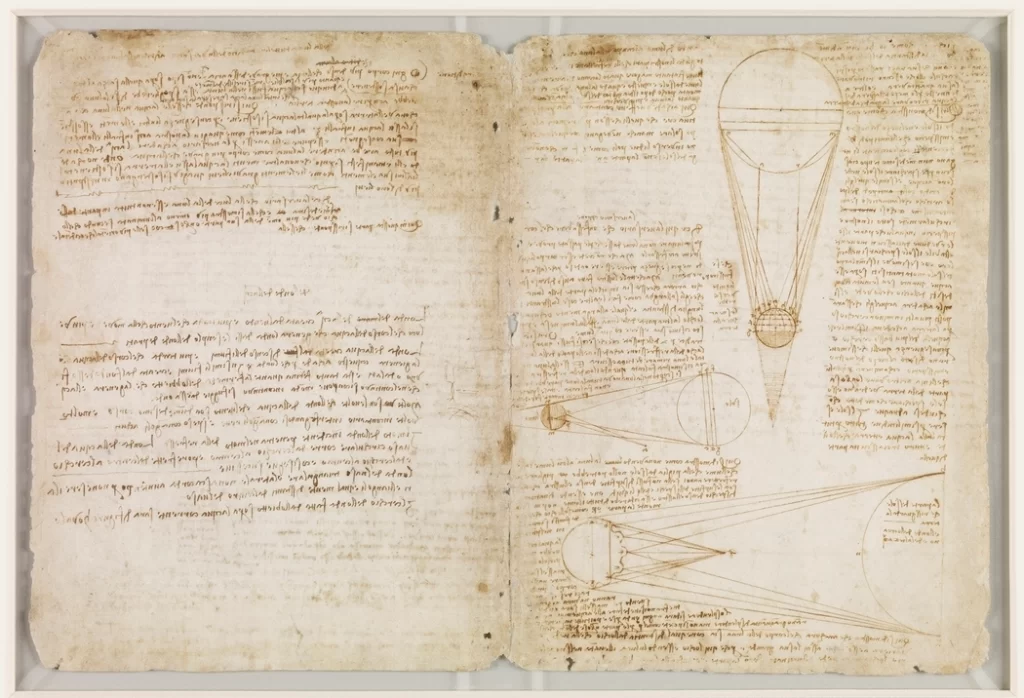
Codex Leicester fascinates many who wonder what makes it stand out from all other books and manuscripts.
If you have ever been curious about rare objects, you may have struggled to understand why this particular notebook is so prized.
This article will explain what sets Codex Leicester apart and the details that make it extraordinary.
Codex Leicester’s value and uniqueness come from its direct connection to Leonardo da Vinci, original scientific ideas, and beautiful illustrations, which offer a rare look into the mind of one of history’s greatest thinkers.
This one-of-a-kind notebook holds pages filled with da Vinci’s thoughts, sketches, and observations about astronomy, water, and light.
People continue to study Codex Leicester because it is not just a historical document, but a unique window into a genius’s process and creativity.
Today, Codex Leicester is known as the most expensive book ever sold.
Major collectors like Bill Gates recognize its lasting importance and have made its images available worldwide.
If you are interested in the story behind its price and what makes it irreplaceable, exploring its background and contents can help you understand why it holds such a special place in history.
The Historical and Artistic Significance of Codex Leicester
Codex Leicester is a rare window into Leonardo da Vinci’s mind, capturing his scientific notebook work and artistic vision.
Its history, insightful manuscript content, and detailed drawings make it a central artifact for historians and art scholars.
Leonardo da Vinci’s Genius Captured in the Codex Leicester
Leonardo da Vinci’s genius shines through in the Codex Leicester.
This scientific notebook gathers his research on water flow, hydrodynamics, lunar influence, and geology.
Across its pages, Da Vinci documents ideas on how rivers erode land or how moonlight impacts the movement of tides.
He writes his observations in his distinctive left-handed “mirror writing.”
These notes reveal scientific observations, experiments, and new theories often centuries ahead of their time.
Codex Leicester shows his curiosity about the world and drive to understand nature’s workings, blending art and science in his research.
The Codex Leicester as a Rare Renaissance Manuscript
This manuscript dates back to the Renaissance and has survived for five centuries.
The Codex Leicester is a rare example of Leonardo’s scientific notebooks and remains unique among his codices because it is complete and well-preserved.
It comprises 72 pages (36 double-leaf sheets) filled with Leonardo’s original writing and sketches.
As a Renaissance artifact, it highlights the period’s passion for discovery and merging art with scientific thought.
Today, the Codex Leicester is often displayed in museums and special exhibitions, such as the Uffizi Gallery.
Exploring Leonardo’s Sketches and Detailed Drawings
Leonardo’s sketches in the Codex Leicester are highly detailed and show every stage of his scientific process.
The drawings include diagrams of water swirling in eddies, cross-sections of riverbeds, and close-up views of fossils.
Each illustration connects directly to Leonardo’s observations and experiments.
He uses these drawings to test engineering concepts like water wheels and dams.
Codex Leicester’s combination of images and text demonstrates how he used sight and reasoning to develop new scientific ideas.
The manuscript is one of the best examples of his ability to visualize natural phenomena and inventions.
The Artistic Value and Leonardo’s Influence on Art
The Codex Leicester is important for both science and art.
Leonardo’s skill in drawing and careful observation set new standards for scientific documentation and artistic technique.
His attention to shading, texture, and proportion gives the manuscript an artistic value that rivals his famous paintings.
Art historians study the Codex Leicester to understand Leonardo’s influence on art during the Renaissance.
His technique of combining observation with imagination influenced later artists and even modern scientific illustration.
The Codex Leicester serves as proof of his legacy as both an artist and a pioneer of scientific drawing.
Codex Leicester’s Historical Artifact Status and Provenance
Codex Leicester has a rich ownership history, adding to its status as a significant historical artifact.
Sir Thomas Coke, later the Earl of Leicester, purchased the manuscript in 1717, which is how the codex got its name.
It passed through several private collectors before Microsoft co-founder Bill Gates acquired it at auction in 1994.
Today, the Codex Leicester is considered the most valuable manuscript ever sold.
Bill Gates loaned it to public exhibitions, making it accessible for research and conservation.
Its story of ownership reflects the manuscript’s ongoing legacy and cultural power as a rare Renaissance artifact and scientific treasure.
Scientific Insights and Innovations in Codex Leicester
Codex Leicester includes Leonardo da Vinci’s detailed observations and careful notes, showing his unique mind at work.
It offers examples of how Leonardo’s scientific documentation blended curiosity, experiment, and sharp thinking to reveal many discoveries.
Leonardo’s Scientific Notebook: A Window into Renaissance Science
The Codex Leicester is a window into Renaissance thought.
It is filled with over seventy pages of Leonardo da Vinci’s handwriting, sketches, and drawings.
He recorded his experiments, detailed ideas, and questions about the natural world.
This scientific notebook details his ideas about geology, fossils, the properties of water, light, and Earth’s structure.
Leonardo’s scientific work blends art with scientific curiosity. He used precise sketches to illustrate each idea visually.
The manuscript highlights his habit of testing theories with hands-on experiments.
Leonardo’s observations set a standard for combining careful notes, direct research, and creative thinking in scientific study.
Hydrodynamics and Water Movement in Leonardo’s Studies
One of the main themes in Leonardo’s studies is hydrodynamics, the science of water movement.
In the Codex Leicester, he drew river currents, water flows, eddies, and the effects of obstacles on stream patterns.
Leonardo documented how water shapes land over time, causing erosion and forming riverbanks.
He explored the idea of water as a force of change in nature.
His notes explain why water follows spiral paths and forms whirlpools and waves.
He described ways humans might use the force of water for power and explained the movement of sediment.
These studies also include his thoughts on water management for cities and agriculture.
Astronomy and Lunar Influence in Codex Leicester
Leonardo’s curiosity led him to astronomy and lunar studies.
In the Codex Leicester, he described why the Moon shines and what causes its phases.
He explained that the Moon’s light comes from reflected sunlight, including how “Earthshine” makes the dark part of the Moon dimly visible.
The manuscript holds his notes on the moonlight effect and how the position of the Moon affects tides.
Using scientific reasoning, Leonardo questioned old beliefs about the stars and planets.
He recorded observations about ancient fossils found on mountaintops, leading to early ideas about Earth’s changes.
This approach shows his drive to challenge existing ideas using direct study.
By observing natural phenomena, Leonardo advanced astronomy and early earth sciences.
Leonardo’s Engineering Concepts and Mechanical Designs
Leonardo’s genius shines through in his engineering concepts and mechanical designs within the Codex Leicester.
The manuscript includes sketches of waterwheels, canal designs, and ideas for machines used in construction and land management.
His drawings show a deep understanding of how engineering and nature connect.
Leonardo wanted to harness the power of water for useful inventions, such as devices to move or lift water.
His engineering proposals reflect both creativity and scientific research.
Tables and diagrams in the manuscript help explain the working parts of his machines and tools.
Leonardo’s inventions connect science, art, and industry, setting a path for later developments in mechanical engineering.
The Importance of Leonardo’s Scientific Observations and Experiments
Leonardo’s detailed observations and experiments in the Codex Leicester set a model for scientific study.
He relied on direct evidence, careful measurements, and precise notes to explain what he saw.
He often tested theories before concluding, sometimes changing his mind when new evidence appeared.
Leonardo’s research explored geology, fossils, water, and astronomy.
His work influenced future studies in natural science.
The Legacy, Conservation, and Modern Relevance of Codex Leicester

Codex Leicester is a rare manuscript that reveals Leonardo da Vinci’s scientific notebook and highlights the Renaissance link between art, science, and innovation.
Its handwritten pages document scientific observations and experiments that inspire modern thinkers.
Codex Leicester Ownership, Sale, and Auction History
The Codex Leicester has a unique journey of ownership.
Leonardo da Vinci wrote it from 1506 to 1510, and the manuscript changed hands several times over the centuries.
In the early 18th century, the Earl of Leicester, Thomas Coke, purchased the codex, giving it its most famous name.
It became the most expensive book ever sold when Bill Gates bought it at auction in 1994, paying about $30.8 million.
This sale, known as the Codex Leicester auction, captured wide attention and increased its fame.
Its ownership history highlights the codex’s rarity and status as a valued historical artifact, bridging centuries of science and curiosity.
Digitization and Public Display of Leonardo’s Notebooks
Modern technology helps preserve and share the Codex Leicester with the world. Since Bill Gates acquired the manuscript, experts have scanned and digitized it.
This process lets scholars and the public study Leonardo’s handwriting, drawings, and scientific notes without risking damage to the original. The Codex Leicester appears in international exhibitions.
Museums use interactive digital displays so viewers can explore pages up close. These displays help people understand Leonardo’s theories, from hydrodynamics to lunar studies.
Institutions like the Minneapolis Institute of Art have shown digital presentations, which make the codex accessible to people who cannot see it in person.
Codex Leicester’s Contributions to Modern Scientific Research
Leonardo’s detailed observations in the Codex Leicester still matter today. The manuscript covers water movement, geology, fossils, moonlight, and astronomy.
Leonardo’s notes offer early insights into Earth sciences and hydrodynamics. Modern researchers analyze the Codex Leicester to trace the origins of scientific methods and experimental thinking.
His research on water flow informs modern engineering, especially in studying rivers, erosion, and soil conservation. Leonardo’s lunar studies and thoughts on the Moon’s reflection on water show his curiosity and foster learning across different sciences.
Conservation Efforts Preserving This Rare Manuscript
The Codex Leicester is old and fragile, so preservation is critical. Experts store it in climate-controlled storage to protect Leonardo’s handwriting and drawings from environmental damage.
Paper specialists check for chemical deterioration and prevent light or moisture from causing harm. Special treatments stabilize ink and parchment, repair tears, and use reversible mounting for public display.
Strict protocols guide every step when moving or showing the manuscript. These efforts keep the Codex Leicester safe for future study.
Interdisciplinary Approach: Leonardo’s Art and Science Legacy
Leonardo da Vinci combined detailed sketches, scientific experiments, and artistic vision in the Codex Leicester. His work on geology, fossils, water science, and mechanical design shows how he blended observation and creativity.
He scanned natural phenomena, used precise measurements, and questioned accepted views. Art students, engineers, historians, and scientists all reference Leonardo’s theories and notebooks.
The Codex Leicester exemplifies Leonardo’s interdisciplinary approach, uniting art, science, and innovation in one manuscript.
Frequently Asked Questions
The Codex Leicester is a handwritten scientific notebook by Leonardo da Vinci filled with observations, sketches, and theories. It is famous for being one of the most expensive books ever sold and for providing insight into Leonardo’s mind.
What did the Codex Leicester explain?
The Codex Leicester explains a wide range of scientific topics, including water movement, the moon’s brightness, and the formation of fossils. Leonardo’s notes show observations on astronomy, geology, and hydrodynamics.
The notebook includes theories that were ahead of his time.
Why is Codex Leicester so expensive?
The Codex Leicester is rare and was written by Leonardo da Vinci himself. It is the only major da Vinci notebook that is still in private hands and not in a museum.
Its high value also comes from its historical and scientific importance and connection to a famous artist.
How much did Bill Gates pay for the Codex Leicester?
Bill Gates bought the Codex Leicester at an auction in 1994, paying $30.8 million for the manuscript.
This set a world record for the most expensive book ever sold at the time.
Where is Leonardo da Vinci’s notebook today?
Today, Bill Gates owns the Codex Leicester. He sometimes loans it to museums for public display.
The codex often travels for exhibitions around the world.
Why is the Codex so important?
The codex gives direct insight into Leonardo da Vinci’s thought process. It is crucial for its pioneering scientific ideas and detailed sketches.
The codex also shows how da Vinci blended art and science in his work.
What is the most expensive Leonardo da Vinci book?
The Codex Leicester is the most expensive book by Leonardo da Vinci ever sold. No other da Vinci manuscript has matched its auction price.
The codex holds a unique place in art and science history.
What was the purpose of the codex?
Leonardo da Vinci used the Codex Leicester to record his scientific studies. It aimed to document his research, experiments, and ideas about nature and the physical world.
Why did Da Vinci write backwards?
Leonardo da Vinci often wrote in mirror writing, from right to left. Scholars believe he did this to make his notes harder to read by others or because it was easier for him as a left-handed writer.
What was written in the codex?
The codex covers topics such as river flow, water properties, geology, astronomy, and fossils. It includes detailed drawings and step-by-step observations.
The content helps historians understand what interested da Vinci in science.
What book sold for 30.8 million dollars?
The Codex Leicester was sold at auction for $30.8 million in 1994.
Bill Gates bought the manuscript and still owns it today.




 Leonardo Bianchi,
the creator of Leonardo da Vinci's Inventions.
Thank you for visiting
Leonardo Bianchi,
the creator of Leonardo da Vinci's Inventions.
Thank you for visiting